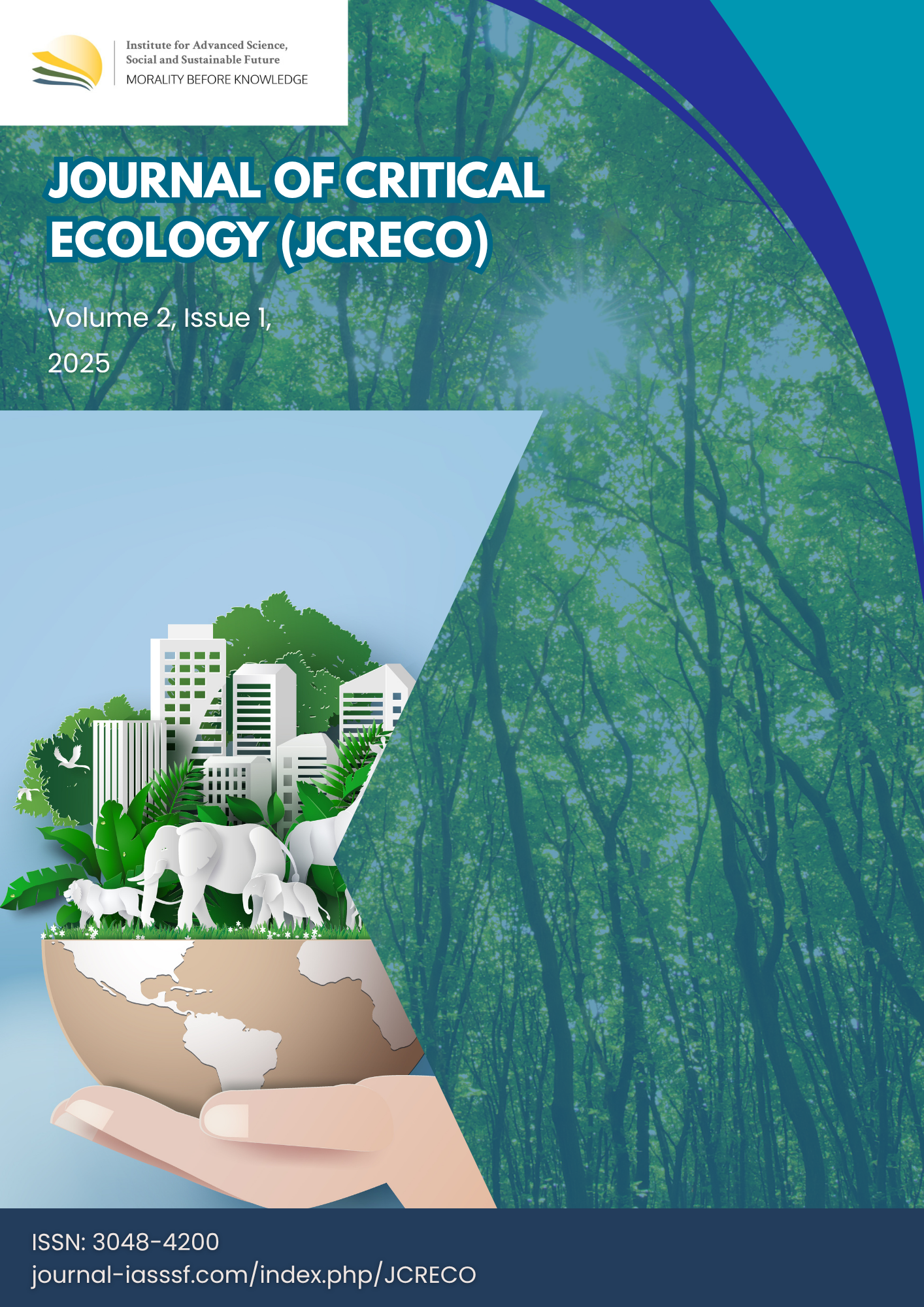Critical review of mine closure regulations and alignment with ecological restoration principles
DOI:
https://doi.org/10.61511/jcreco.v2i1.1743Keywords:
ecological restoration, mine closure, regulationAbstract
Background: Indonesia, as one of the largest coal producers and exporters, faces negative impacts of mining such as water quality degradation, landscape changes, and social conflicts. Although the government has various regulations from MEMR and MoEF, the implementation of mine reclamation is often suboptimal, hampering ecological and biodiversity recovery. This study examines environmental regulations, especially related to mine closure issued by the two ministries. Methods: This study uses a literature study method by analyzing mining closure regulations in Indonesia, including the Decree of the Ministry of Energy and Mineral Resources No. 7/2014, the Decree of the Minister of Environment No. 3/2014, and the Decree of the Minister of Finance No. P.60/Menhut-II/2009, and their relation to ecological restoration. The analysis was conducted using the content analysis method to extract conclusions from related documents, focusing on the criteria for the success of reclamation and mine closure. Findings: There are differences in mine closure regulations with ecological restoration criteria, which show that the Minister of Energy and Mineral Resources Regulation No. 7/2014 has the highest suitability with a score of 54.55%. This analysis reveals that the Minister of Energy and Mineral Resources Regulation emphasizes stakeholder consultation, rehabilitation planning, and monitoring, while the Minister of Forestry Regulation No. 60/2009 focuses more on vegetation formation and erosion control, and the Minister of Environment Regulation No. 3/2014 provides guidelines for biodiversity management and fauna recolonization. conclusion: This study shows that the current reclamation and post-mining regulations from the Ministry of Energy and Mineral Resources, Ministry of Forestry, and Ministry of Environment require coordination to create regulations that ensure sustainable mining in Indonesia. Novelty/Originality of This Study: The novelty of this study lies in its critical analysis of regulatory gaps, highlighting the need for synchronized policies to ensure effective ecological restoration in the mine closure phase.
References
Ardiyanto , W . & Isaac, Y. (2017). Assessment Policy for the Success of Post-Coal Mine Reclamation in Indonesia. Journal of Forestry Policy Analysis Vol.4, No.2 ,: 121-136.
British Petroleum. (2017). BP Statistical Review of World Energy June 2017. www.bp.com
CEIC. (2017). Indonesia coal production. CEIC Data. https://www.ceicdata.com/en/indicator/indonesia/coal-production
Cornot-Gandolphe, S. (2017). Indonesia's electricity demand and the coal sector: export or meet domestic demand?. The Oxford Institute for Energy Studie. https://www.oxfordenergy.org/publications/indonesias-electricity-demand-coal-sector-export-meet-domestic-demand/
Dessai, A. G. (2023). Mining Industry. In Environment, Resources and Sustainable Tourism: Goa as a Case Study (pp. 39-69). Singapore: Springer Nature Singapore. https://doi.org/10.1007/978-981-99-1843-0_3
Devrath, S. C., Nag, A., & Pareek, S. (2025). Transforming Mining Regions through Sustainable Redevelopment with Urban Voids and Underground Housing. Journal of Mining and Environment, 16(4), 1319-1342. https://doi.org/10.22044/jme.2025.15649.3005
Environmental Agency District Paser. (2018). Proses penetapan tahura lati petangis. Environmental Agency District Paser. http://dlh.paserkab.go.id/detailpost/proses-penetapan-tahura-lati-petangis
Environmental Law Alliance Worldwide. (2010). Guidebook for Evaluating Mining Project EIAs. Environmental Law Alliance Worldwide Journal. https://elaw.org/resource/guidebook-evaluating-mining-project-eias
Hazarika, P., Talukdar, N. C., & Singh, Y. P. (2006). Natural colonization of plant species on coal mine spoils at Tikak Colliery, Assam. International Society for Tropical Ecology.
Hobbs, R. J., & Norton, D. A. (1996). Towards a conceptual framework for restoration ecology. Restoration ecology, 4(2), 93-110. https://doi.org/10.1111/j.1526-100X.1996.tb00112.x
Igogo, T., Awuah-Offei, K., Newman, A., Lowder, T., & Engel-Cox, J. (2021). Integrating renewable energy into mining operations: Opportunities, challenges, and enabling approaches. Applied Energy, 300, 117375. https://doi.org/10.1016/j.apenergy.2021.117375
Indonesian–Investment. (n.d.). Coal. Indonesian–Investment. https://www.indonesia-investments.com/business/commodities/coal/item236?
Krippendorff, K. (1980). Validity in content analysis. Computerstrategien für die Kommunikationsanalyse, (291), 69-112. https://repository.upenn.edu/handle/20.500.14332/1940
Lima, A. T., Mitchell, K., O’Connell, D. W., Verhoeven, J., & Van Cappellen, P. (2016). The legacy of surface mining: Remediation, restoration, reclamation and rehabilitation. Environmental Science & Policy, 66, 227-233. https://doi.org/10.1016/j.envsci.2016.07.011
Listiyani, N., Said, M. Y., & Khalid, A. (2023). Strengthening Reclamation Obligation through Mining Law Reform: Indonesian Experience. Resources, 12(5), 56. https://doi.org/10.3390/resources12050056
Lopes da Costa., & Carlos, J. (2020). Environmental financial assurance: current coverage, institutional challenges, and alternative financial guarantee arrangements. University of British Columbia. https://dx.doi.org/10.14288/1.0390675
McGuire, G. M. (2003). Managing Mine Closure Risks in Developing Communities- A Case Study, Kelian Equatorial Mining, Indonesia. Mining Risk Management, 75-82. https://www.ausimm.com/publications/conference-proceedings/mining-risk-management/managing-mine-closure-risks-in-developing-communities---a-case-study-kelian-equatorial-mining-indonesia/
Michaux, S. P. (2021). The mining of minerals and the limits to growth. Geological Survey of Finland: Espoo, Finland. https://tupa.gtk.fi/raportti/arkisto/29_2025.pdf
MMSD. (2002). Research on Mine Closure Policy. IIED. https://www.iied.org/g00541
Nichols, O. G., Grant, C., & Bell, L. C. (2005). Developing ecological completion criteria to measure the success of forest and woodland establishment on rehabilitated mines in Australia. Proceedings America Society of Mining and Reclamation, 807-830. https://www.asrs.us/Publications/Conference-Proceedings/2005/0807-Nichols.pdf
Pactwa, K., Konieczna-Fuławka, M., Fuławka, K., Aro, P., Jaśkiewicz-Proć, I., & Kozłowska-Woszczycka, A. (2021). Second life of post-mining infrastructure in light of the circular economy and sustainable development—recent advances and perspectives. Energies, 14(22), 7551. https://doi.org/10.3390/en14227551
Prasad, B. D. (2008). Content analysis: A method of Social Science Research. Rawat Publications.
Sengupta, M. (2021). Environmental impacts of mining: monitoring, restoration, and control. CRC Press. https://doi.org/10.1201/9781003164012
Sikdar, P. K. (2021). Environmental impact assessment. In Environmental management: issues and concerns in developing countries (pp. 253-283). Cham: Springer International Publishing. https://doi.org/10.1007/978-3-030-62529-0_12
Syafni, R., Budidanta, D., & Ridho, M. R. (2022). Study on The Quality of Environmental Impact Assessment Documents Evaluated by EIA Assessment Commission of South Sumatra Province for Preventing Environmental Degradation. Sriwijaya Journal of Environment, 6(3), 121-126. http://dx.doi.org/10.22135/sje.2021.6.3.121-126
Tibbett, M. (2024). Post-mining ecosystem reconstruction. Current Biology, 34(9), R387-R393. https://doi.org/10.1016/j.cub.2024.03.065
Turisno, B. E. (2022). Ecological impacts and socio-legal infrastructure as an approach to environmental management in ex-mining land reclamation. International Journal of Sustainable Development and Planning, 17(7), 2279-2285. https://doi.org/10.18280/ijsdp.170729
Wambwa, D., Mundike, J., & Chirambo, B. (2025). Balancing economic development, social responsibility, and environmental conservation through financial assurance programs in sub-Saharan Africa’s mining industry. Environment, Development and Sustainability, 27(3), 5869-5892. https://doi.org/10.1007/s10668-023-04205-w
Weber, R. P. (1990). Basic Content Analysis. Sage.
Wisnumurti, R. W. (2024). Authority Of Local Governments In Issuing Environmental Impact Assessment Permits. Jurnal Hukum Sehasen, 10(1), 227-236. https://doi.org/10.37676/jhs.v10i1.5934
Wu, X., Xing, C., Ju, Q., Su, S., Zhang, X., & Zhu, T. (2024). Research progress in mining ecological restoration technology. Journal of Industrial Safety, 1(1), 100004. https://doi.org/10.1016/j.jinse.2024.100004
Zhenqi, H., Peijun, W., & Jing, L. (2012). Ecological restoration of abandoned mine land in China. Journal of Resources and Ecology, 3(4), 289-296. https://doi.org/10.5814/j.issn.1674-764x.2012.04.001
Downloads
Published
Issue
Section
Citation Check
License
Copyright (c) 2025 Arief Adi Pradana

This work is licensed under a Creative Commons Attribution 4.0 International License.















